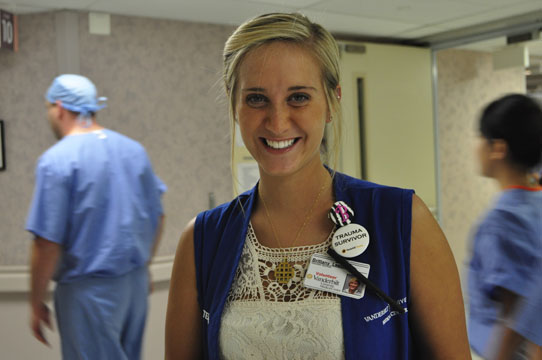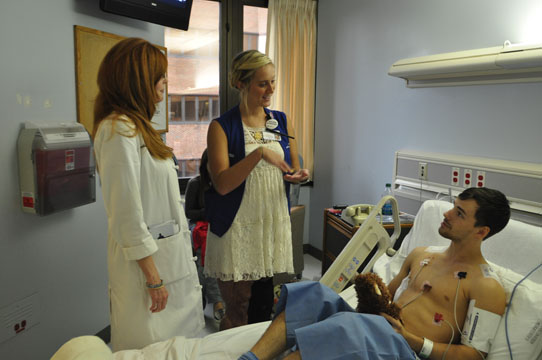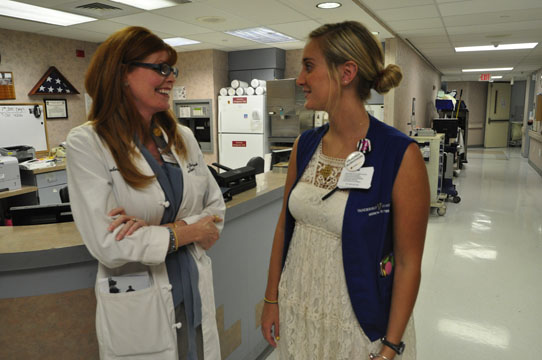
Brittany Leedham was severely injured in a car accident in 2008 when she was a senior at Father Ryan High School. She now volunteers as a Peer Visitor with the Trauma Survivors Network at the Vanderbilt University Medical Center. She talks with patients and their families in Vanderbilt’s Trauma Unit and the Stallworth Rehabilitation Center, where she was treated after the accident, about her experiences and what they can expect.
By Ned Andrew Solomon
This article first appeared in The Tennessee Register.
When Brittany Leedham visits with patients and families at Vanderbilt University Medical Center’s Trauma Center, she brings a unique perspective. Three years ago, Leedham was a patient there herself, having barely survived a car accident in Brentwood that killed her boyfriend, Zak Kerinuk.
Leedham, who graduated from Father Ryan High School in May 2009, volunteers as a Peer Visitor with the Trauma Survivors Network, a two-year old initiative at Vanderbilt designed to provide care, support and resources for families whose loved one has undergone a significant trauma, such as brain injury, spinal cord injury, amputation or multiple fractures – like Leedham. There are currently six fully operational TSNs in the country; Vanderbilt’s Network is the only one in Tennessee.
“It was brought here because a lot of programs deal with support, with cancer and heart disease,” said Susan Sutton, MPH, TSN’s program manager. “Vanderbilt has a high volume of trauma patients – over 3,000 a year – and we have a need for resources and support for our survivors.”
Leedham provides some of that support, and her visiting has proved beneficial to her own recovery as well.
“When Brittany comes out of a patient’s room, when she’s been chatting with a family for 45 minutes, she kinda gets a little bit of a ‘happy rush,’” said Sutton. “She knows that what she’s just said to them made a difference, made them feel better. And because it didn’t come from a doctor, or from me, or from a nurse – it came from somebody who really was in that hospital bed.”
Long Road
It’s been a long road from “that hospital bed” to being able to comfort families. Especially when you consider Leedham is walking into those rooms.
The car accident left her with three broken fingers, a pelvic bone broken in two places, and a completely shattered C2 vertebrae. She spent two weeks at Vanderbilt’s Trauma Center, four weeks in Vanderbilt Trauma Step-Down, four weeks at Vanderbilt Children’s Hospital and four weeks at Vanderbilt Stallworth Rehabilitation Hospital.
“We were told that she would probably lose her legs,” said Teresa Leedham, Brittany’s mom. “And if she kept them, she would never walk.”
Just six months after the accident Leedham did walk, along with her Father Ryan peers at graduation, aided by small-based quad canes. Today she walks independently to her classes at Middle Tennessee State University, thanks to countless hours of physical therapy and 21 surgeries, all on her legs.
The 21st was only a short time ago. “That was my last needed surgery,” said Leedham. “Anything else that comes along will be to remove a screw that came loose or whatever. I have rods and plates and screws and anchors in both legs.”
With all those foreign, man-made elements inside her, Leedham can tell when the weather’s changing, or if it’s going to rain. “I get a different kind of stiffness, and a different type of pain than the average person,” Leedham said. “I just kind of push and go through it.”
That kind of “push and go though it” perseverance has made her a valuable, and inspiring, Peer Visitor at the Trauma
Center, as well as at Stallworth. “She comes in with her bubbly smile, and you’re like, ‘Good grief, if she can make it, I can make it,’” said Sutton.
Leedham first met Sutton at the TSN’s first fundraiser, an NFL “watch party.” Although Leedham expressed an interest in being a Peer Visitor, she was still undergoing surgeries and the timing wasn’t right. Almost a year later, Leedham dropped in to see Sutton to tell her she thought she was ready to volunteer. So, when the next round of Peer Visitor training sessions was scheduled, Leedham took part. “And Brittany has been awesome ever since,” said Sutton.
But it’s not just Leedham’s positive attitude that makes her an “awesome” asset to the TSN. The feedback that Sutton gets from families is that they appreciate her candor. “She doesn’t sugarcoat what it’s like up there,” Sutton said. “She tells you it was awful. The beds are uncomfortable and the pain pump is there for a reason. Brittany also has the experience of being the sole survivor in a motor vehicle crash. So, she lends quite a bit of sage advice and wisdom for someone who is only 20 years old.”
Peer Visitors are formally trained, and are official “Vanderbilt Volunteers,” having completed a background check, medical check and privacy law compliance coursework. Once they’ve passed those elements, each Peer Visitor participates in a detailed TSN training.

Brittany Leedham, center, and Susan Sutton, left, the program manager of the Trauma Survivors Network at Vanderbilt University Medical Center, talk with a patient in Vanderbilt’s Trauma Unit.
Dark days
Among many other components, Peer Visitors are taught not to give false hope or medical advice. However, there don’t appear to be any
specific rules around discussing one’s faith, which works out well for Leedham, a parishioner at St. Edward Church who is also actively involved in her Catholic community at college.
“I always wear my SEARCH cross, and I run into more people that recognize that,” said Leedham. “Most of the people on the Trauma Unit are hanging on to some sort of faith. So, it’s real easy for them to just bring it up. I’ve prayed with families in the middle of the waiting room. I’ve shared my experience and the battle I did with faith.”
Losing her boyfriend, who was a Father Ryan graduate, and potentially the use of her legs, Leedham had serious doubts about the point of it all, and who was in charge. “She was mad,” said Teresa Leedham. “She was mad at God; she was mad at everyone in the world.”
“I figured there couldn’t be a God if I was hurting this bad,” said Leedham. “What kind of God would do something like this? Out of all the horrible people in the world … I was a good person! A great person! Yet, this happened to me.”
Leedham tried taking mood stabilizers to elevate her from a perpetual funk. But since those made her feel little more than numb, she stopped taking them, determined that she could do it herself without help from anybody or anything. Soon after she hit a “wall,” and a string of ever-worsening days. “And people would say, ‘God saved you for a reason’, and I’d say, ‘Really?’” recalled Leedham. “‘Could you tell me what those reasons are, cuz I don’t have any.’”
She went to see her pediatrician – who she still sees as a college student – and was prescribed a more effective medication. The doctor also recommended she get some counseling, but Leedham was resistant, claiming her friends and family were all she needed. Under duress, Leedham agreed to see a counselor at Catholic Charities. During the first couple of sessions Leedham didn’t say a word.
She hit another series of dark days, but finally experienced a breakthrough at one of her Catholic Charities appointments. Leedham felt like she was slowly “returning” to herself, and had more of a desire to re-engage with the world. That improved attitude culminated in a three-day backpacking trip in the spring with her MTSU Outdoor Pursuits class up to Hobb’s Cabin on the Cumberland Plateau.
To get to Hobb’s Cabin it’s almost directly straight up, and at one point, backpackers have to navigate a challenging boulder field – tough even for a person with two typically functioning legs. It seemed like an impossible task, but with the encouraging assistance of her group mates, Leedham made it through.
“As soon as I saw that Hobbs Cabin sign at the top of the plateau … and I’m good with words, but I can’t even put into words what that felt like,” said Leedham. “We went to the overlook, and I looked over at everything we had climbed up, and it was just like everything over the past two years. And I got a deeper feeling of God than I ever got in a church. It was like I had something to prove, and that was it. When I made it to the top of Hobb’s Cabin it was like I let go of that grudge I had with God, and it was the best feeling in the world.”

Brittany Leedham, right, speaks with Susan Sutton, left, the program manager of the Trauma Survivors Network at Vanderbilt University Medical Center.
Looking to the future
The backpacking excursion is an aspect of Leedham’s double major in recreational therapy and outdoor recreation. She eventually hopes to have a master’s degree in wilderness therapy. None of this would have come about without her work at Stallworth – and how she was treated there.
When Leedham had been at Stallworth a week, her therapist recommended she go to “rec therapy,” but the sullen patient just wanted to go back to her room and sleep. With her therapist’s goading, she decided to give it a try.
“I put myself in the elevator, got myself to the third floor, and wheeled myself in, and they’re playing the Wii,” said Leedham. “I thought, ‘Why didn’t anybody tell me about this therapy? This is awesome!’ So I rolled in, sat next to a guy who had lost his leg, and he asked me if I bowled.
“We bowled for an hour,” continued Leedham. “For that one hour, I didn’t have people asking me to rate my pain on a scale of one to 10. People didn’t ask me how I was doing mentally. I wasn’t worried about walking, I wasn’t worried about anything else. I wasn’t Brittany from the car accident. I wasn’t the girl who lived. I was just Brittany, and it was a nice break from reality.”
In addition to playing Wii, the patients did activities like balloon volleyball, making homemade ice cream, and attending a Predator’s game. “It was so nice to be ‘normal,’ and I realized that was what I wanted to do,” said Leedham.
In fact, for a person who almost wasn’t here anymore, she’s getting to do many things she wants to do. She is living a very full life as a student at MTSU, a volunteer with the TSN, and as a beacon of light to individuals and family members who aren’t sure what the next day will bring, or if there’ll be a next day.
Speak Your Mind